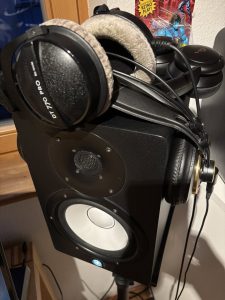
The Right Monitoring in Your Studio – What Really Matters
You’ve probably experienced this: Your mix sounds perfect in your home studio, but as soon as you play it in the car, on a stereo system, or through other speakers, everything falls apart. The mids clash, the bass is either too strong or too weak, and the highs are either too sharp or too dull.
The market is flooded with solutions – from studio monitors and headphones to measurement microphones and acoustic panels. While these can certainly improve your sound, they won’t necessarily fix your mixing issues. In my experience, the real key lies elsewhere: knowing your monitoring system inside and out.
Listen to as much music as possible on your studio monitors until you fully understand their sound characteristics. This allows you to compare your mixes to professional productions and identify problem areas. I find it essential to use reference tracks and switch between them and my mix in an A/B comparison. It also helps to isolate certain frequency ranges with an EQ to analyze them more precisely.
In the final mixing phase, I often test my tracks on various consumer headphones and Bluetooth speakers to ensure they translate well across different playback systems.
How do you approach this? What strategies do you use to optimize your sound?
